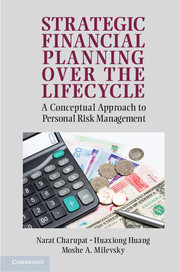Book contents
- Frontmatter
- Contents
- Acknowledgments
- 1 Introduction and Motivation
- 2 Mathematical Preliminaries – Working with Interest Rates
- 3 Personal Balance Sheet and Human Capital
- 4 Consumption Smoothing and Optimal Savings
- 5 Debts, Loans, and Mortgages [Canadian Content]
- 6 Personal Income Taxes [Canadian Content]
- 7 Risk, Utility, and Insurance
- 8 Mortality Risk and Life Insurance
- 9 Investment and Diversification
- 10 The Mathematics of Portfolio Diversification
- 11 Housing Decisions
- 12 Pensions and Retirement [Canadian Content]
- 13 Advanced Material: Part I. Continuous Time and the Calculus of Variations
- 14 Advanced Material: Part II. Stochastic Optimal Control and the HJB Equation
- 15 Concluding Thoughts and Next Steps
- Bibliography
- Index
3 - Personal Balance Sheet and Human Capital
Published online by Cambridge University Press: 05 June 2012
- Frontmatter
- Contents
- Acknowledgments
- 1 Introduction and Motivation
- 2 Mathematical Preliminaries – Working with Interest Rates
- 3 Personal Balance Sheet and Human Capital
- 4 Consumption Smoothing and Optimal Savings
- 5 Debts, Loans, and Mortgages [Canadian Content]
- 6 Personal Income Taxes [Canadian Content]
- 7 Risk, Utility, and Insurance
- 8 Mortality Risk and Life Insurance
- 9 Investment and Diversification
- 10 The Mathematics of Portfolio Diversification
- 11 Housing Decisions
- 12 Pensions and Retirement [Canadian Content]
- 13 Advanced Material: Part I. Continuous Time and the Calculus of Variations
- 14 Advanced Material: Part II. Stochastic Optimal Control and the HJB Equation
- 15 Concluding Thoughts and Next Steps
- Bibliography
- Index
Summary
Learning Objectives
In this chapter, we talk about personal balance sheets, which are snapshots of our financial position at a point in time. We then discuss the concept of human capital that, as we will argue, should be included in everyone's personal balance sheet.
Personal Balance Sheets
A starting point in the personal financial-planning process is to assess our current financial situations. This is typically done by preparing a personal balance sheet. It is a good exercise for you to create your own balance sheet. Please take out a blank sheet of paper and draw a straight line down the center, splitting the sheet into two equal parts. Write “Assets” on the top left-hand side, and write “Liabilities” at the top right-hand side. On the left-hand side, list the value of your assets, including money in bank accounts, stocks, savings bonds, pension accounts, mutual funds, equity in a small business, house, car, and any other items you can think of. The list does not have to be exhaustive (e.g., you can disregard personal-use assets such as clothing). On the upper right-hand side, make sure to include what you owe on credit cards, consumer loans, student loans, mortgage loans, and any other financial obligations.
Once you have listed all your assets and all your liabilities, add them up to get summary numbers for both. On one side of the balance sheet is the value of everything you own, and on the other side is the value of everything you owe.
- Type
- Chapter
- Information
- Strategic Financial Planning over the LifecycleA Conceptual Approach to Personal Risk Management, pp. 28 - 45Publisher: Cambridge University PressPrint publication year: 2012



